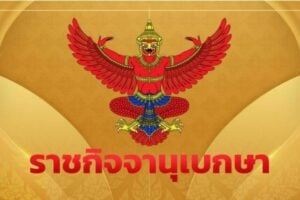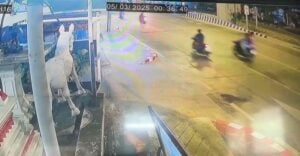Unlocking secrets: Key themes behind Thai street art & graffiti
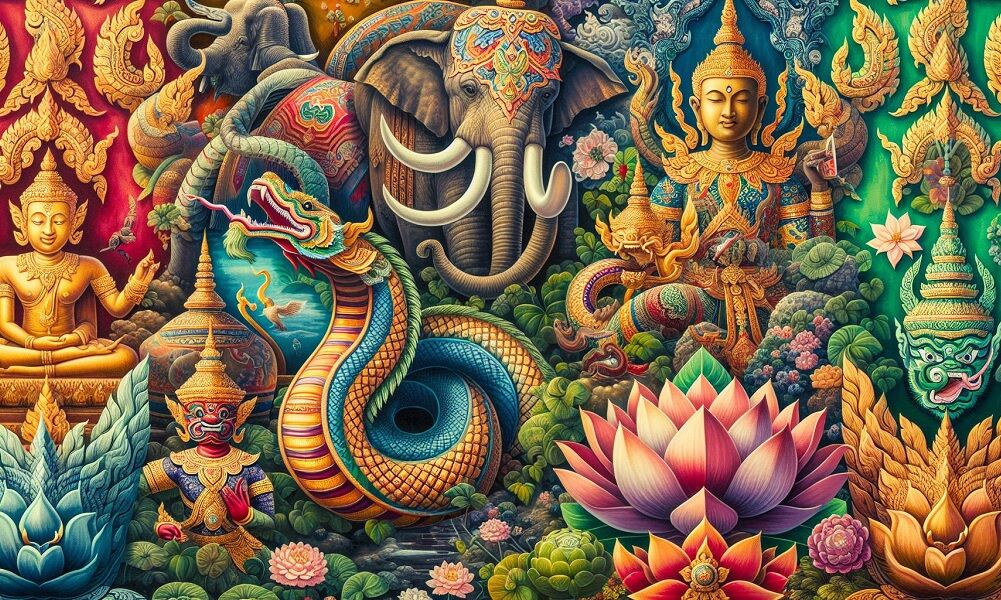
Thai street art and graffiti weave a vibrant tapestry across the urban landscape, each stroke brimming with stories, dreams, and critical commentary. Bangkok, in particular, serves as the canvas for this dynamic expression, where themes of Thai street art reveal the complex interplay between tradition and modernity. Artists employ the streets as open-air galleries, turning public spaces into arenas of visual dialogue.
Common messages in Thai graffiti often take the audience through cultural identity, political thought, and societal issues, allowing passers-by to encounter personal and communal narratives in unexpected places. This art form beautifies the city and prompts reflection among its viewers, offering alternative perspectives on everyday life in Thailand.
The symbolism entwined within Thai street art is rich and varied, drawing from both local heritage and contemporary global culture. It serves as a mirror reflecting Thai society’s aspirations, challenges, and transitions. These symbols range from mythical creatures representing age-old tales to depictions of modern-day heroes, encapsulating the essence of Thai identity and the nation’s evolving story.
Artists in Thailand have mastered the art of communicating through imagery, where even the most fantastical elements carry weighty meanings. This skilful utilization of symbolism makes Thai street art a compelling subject of study, revealing layers of meaning with each viewing. Through their work, graffiti artists invite onlookers to ponder deeper themes of existence, unity, and resistance, whilst also celebrating the beauty inherent in Thailand’s complex cultural fabric.
In exploring the streets of Bangkok and beyond, one can’t help but admire the creativity and resilience of local artists. Their ability to transform ordinary city walls into thought-provoking masterpieces is a testament to the power of art in public spaces. In essence, Thai street art is a beacon of cultural pride and a platform for uncensored expression, intricately linking the past with the present and painting dreams of the future.
Key themes in Thai street art and graffiti
Influence of traditional Thai culture
Thai street art vividly showcases the nation’s rich heritage, intertwining traditional motifs and symbols with contemporary flair. Artists often draw from Thailand’s deep pool of mythology and folklore, breathing new life into ancient tales by depicting them on urban canvases. The imagery, ranging from mythical creatures to iconic Buddhist symbols, serves not only as a nod to the past but also as a bridge connecting the traditional with the modern. This fusion is a powerful reminder of the country’s cultural vibrancy, proving that Thai street art is as much about preserving heritage as it is about innovation.
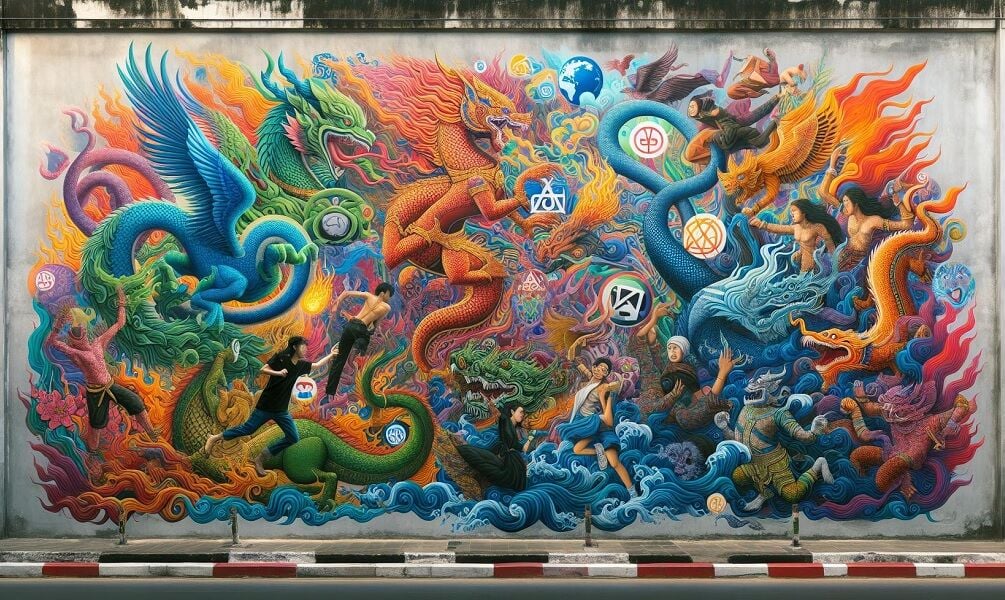
Political and social commentary
Themes of Thai street art frequently delve into pressing societal issues, offering bold commentary on politics, human rights, and social injustice. Artists leverage their work as a platform to inspire change, reflect societal unrest, and provoke thought amongst viewers. Through evocative imagery and poignant messages, these artworks catalyse conversations around common messages in Thai graffiti, including democracy, freedom of expression, and environmental concerns. The walls become mirrors reflecting the public’s hopes and grievances, making street art an essential facet of Thailand’s socio-political landscape.
Pop culture references
In Thai street art, the allure of pop culture is undeniable. Artists incorporate familiar figures from movies, music, and comic books, reimagining them with a local twist. These references not only add a layer of relatability but also serve as a commentary on the global influence of pop culture. By blending international icons with Thai elements, the artwork celebrates the merging of global and local trends. This approach not only attracts a wider audience but also sparks discussions on the impact of Western culture, making Thai street art symbolism a medium of cultural exchange and reflection.
Symbolism in Thai street art
In exploring the world of Thai street art and graffiti, one quickly realises the abundant layers of meaning coursing through the vividly painted cityscapes. Themes of Thai street art often extend beyond mere aesthetics, delving into a realm rich with tradition and contemporary relevance. This section unravels the intricate symbolism that animates Thai street art, offering insights into common messages in Thai graffiti and the deep cultural underpinnings that characterise this expressive form.
Animals and mythical creatures
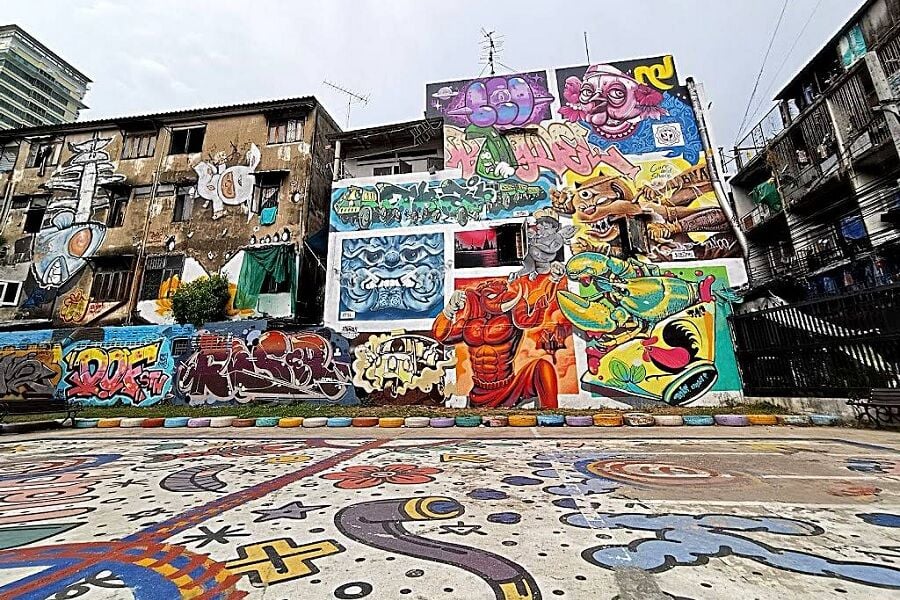 Photo from streetartmap.com
Photo from streetartmap.com
Thai street artists frequently incorporate animals and mythical creatures into their visuals, drawing from a wellspring of folklore and mythology. These figures aren’t just decorative; they carry profound meanings and commentaries on Thai society. Elephants, revered for their wisdom and strength, often symbolise patience and good luck. Meanwhile, serpents from Thai mythology, like the Naga, are depicted to represent protection and prosperity. The presence of these creatures in street art not only beautifies urban walls but also preserves and communicates essential elements of Thai heritage and beliefs.
Buddhist iconography
Buddhist symbols are a cornerstone of Thai cultural expression, and this extends robustly into the realm of street art. Common messages in Thai graffiti explore themes of spirituality, impermanence, and the quest for enlightenment. The lotus flower, appearing frequently in urban murals, embodies purity and the potential for spiritual growth amidst adverse conditions. Murals of the Buddha serve as powerful reminders of mindfulness, peace, and the interconnectedness of all life. Through these images, artists convey messages of hope, reflection, and the pursuit of inner harmony.
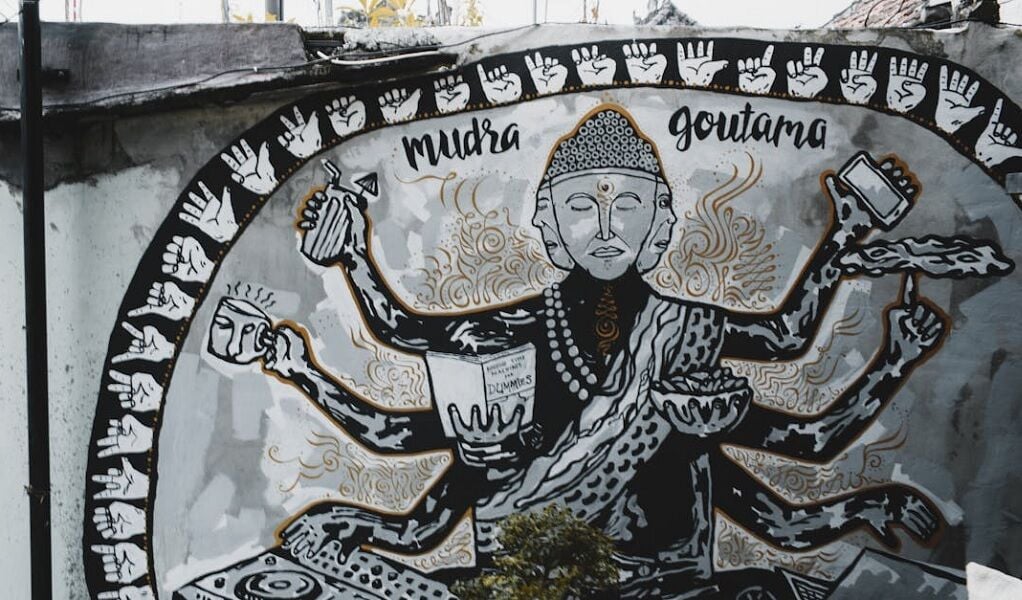
Colour symbolism
The vibrancy of Thai street art is not just a visual feast but a narrative device, with each hue holding particular significance. Red, for instance, is often used to evoke passion, and love, as well as struggle and political dissent. Gold, referencing royalty and divinity, celebrates the country’s spiritual and cultural wealth. Green showcases the importance of nature and life, urging viewers to remember their bond with the natural world. In this way, artists utilise colour not just for aesthetic appeal but as a tool for storytelling, embedding Thai street art symbolism within every brushstroke. Through their mastery of colour, artists bridge tradition with contemporary voices, weaving tales that resonate with locals and visitors alike.
Symbolism in street art: Decoding urban narratives
Political narratives and societal reflections in street art
Street art is a powerful medium for political expression and social commentary. Artists often use potent symbols, like clenched fists for resistance and solidarity or doves for peace and hope, to convey potent political messages. These symbols usually accompany narratives that tackle human rights, environmental issues, and social inequality. Such symbolism in street art encourages viewers to think about societal issues and challenges the status quo.
Celebrating cultural identity and heritage through street art
Street art is intricately tied to cultural identity and heritage. Artists often incorporate indigenous motifs, traditional patterns, and cultural icons into their work, emphasizing the histories and traditions of local communities. These symbols act as a visual tribute to the community’s roots and resilience, reinforcing a sense of pride and belonging among its members.
The power of satire and subversion in street art
Street art often utilizes satirical symbols and imagery to convey its subversive nature. Artists may twist well-known symbols and place them in unexpected contexts to provoke thought and challenge mainstream narratives. This type of symbolism can vary from humorous and irreverent to cryptic, encouraging viewers to question societal norms and authority.
Emphasizing environmental consciousness through artistic symbolism
Nature is a common source of inspiration in street art, with symbols like animals, trees, and flowers frequently representing environmentalism and the importance of nature. These symbols often carry messages about conservation, ecological awareness, and the human impact on the environment. By incorporating natural elements into their art, street artists remind viewers of the delicate balance between urban development and environmental sustainability.
Thailand’s dynamic street art scene does not just navigate the crossroads of tradition and modernity. It also has to contend with a complex legal maze. With ambiguities in laws related to the use of public spaces and the ownership rights of the works, artists continue to paint with a unique blend of caution, creativity, and defiance. Despite these challenges, their ability to convert ordinary city walls into powerful narratives indicates the resilience of Thai artists. This expressive blend of cultural pride, political commentary and societal reflection does not merely brighten up urban corners. It fosters important dialogues, pushing the boundaries of free expression in the improbable canvas that is the urban landscape. This is the cultural and sociopolitical power of Thailand’s vibrant street art scene.















